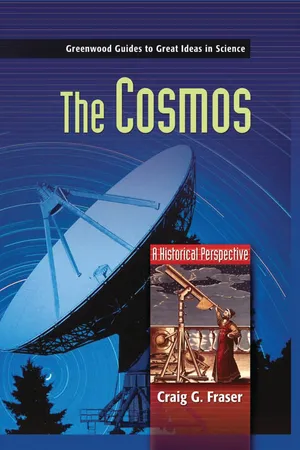
- 200 pages
- English
- PDF
- Available on iOS & Android
About this book
Everyone knows that the universe is extremely old and extremely large. But how did scientists determine just how old and how large? How do astronomers know that there are upwards of 100 billion galaxies in the universe if the nearest one is over 40, 000 light-years away? How do we know what the stars are made of? The answer is that our current knowledge of the universe has arisen from the work and ideas of scientists and philosophers over hundreds of years. While it's only been during the last several decades that scientists have had the technology and theories to really understand how the universe works, humans have thought about such issues for millennia. And the scientists who today are attempting to understand the most complex issues of the universe build upon the work and thought of the thinkers of the last hundreds of years. The Cosmos: A Historical Perspective provides an accessible introduction to the many ways humans have conceived of the universe throughout history and what ideas have led to our current understanding of the cosmos. The book examines: the Scientific Revolution and the new ideas of the Earth's place in the cosmos; the importance of nineteenth-century physics and chemistry in determining the compositions of stars; Einstein's Theory of Relativity and how it altered how scientists thought about gravity; and new, cutting-edge science that may alter, yet again, our conceptions of the cosmos, such as the inflationary universe and the possibility of dark energy. Jargon and mathematics is kept to a minimum, and the volume includes an annotated bibliography and a timeline. The Cosmos is an ideal introduction for students studying space science and the history and nature of the scientific understanding of the universe.
Frequently asked questions
- Essential is ideal for learners and professionals who enjoy exploring a wide range of subjects. Access the Essential Library with 800,000+ trusted titles and best-sellers across business, personal growth, and the humanities. Includes unlimited reading time and Standard Read Aloud voice.
- Complete: Perfect for advanced learners and researchers needing full, unrestricted access. Unlock 1.4M+ books across hundreds of subjects, including academic and specialized titles. The Complete Plan also includes advanced features like Premium Read Aloud and Research Assistant.
Please note we cannot support devices running on iOS 13 and Android 7 or earlier. Learn more about using the app.
Information
Table of contents
- CONTENTS
- Series Foreword
- Preface
- List of Illustrations
- 1 Introduction
- 2 Babylonian and Chinese Astronomy and Cosmology
- 3 Greek Astronomy and Cosmology
- 4 Cosmology from Islam to Copernicus
- 5 Cosmology from Brahe to Newton
- 6 Stellar Astronomy: The Universe Beyond the Solar System
- 7 A Universe of Galaxies: The Triumph of the Island-Universe Theory
- 8 The Expansion of the Universe
- 9 From Universal Expansion to the Big Bang
- 10 The Big Bang Universe: From 1965 to the Twenty-First Century
- Timeline
- Glossary
- Bibliography
- Index
- Figure 3.1. Retrograde motion of a superior planet.
- Figure 3.2. Eudoxus's model for retrograde motion.
- Figure 3.3. Hipparchus's solar model.
- Figure 3.4. Ptolemy's model for the planets.
- Figure 3.5. The equant.
- Figure 3.6. Model for solar motion using secondary epicycle.
- Figure 3.7. Equivalence of geocentric and heliocentric models for planetary motion.
- Figure 3.8. The Tychonic system.
- Figure 4.1. The al-Tusi couple.
- Figure 4.2. Al-Shatir's model of the motion of the Moon.
- Figure 4.3. Dante's universe.
- Figure 4.4. The Copernican system.
- Figure 5.1. The Tychonic system.
- Figure 5.2. Figure from Schofield (1981, plate 16).
- Figure 5.3. Kepler's heliocentric system (1596).
- Figure 6.1. A drawing of stars from Galileo's Starry Messenger (1610).
- Figure 6.2. Leonard Digges's universe (1576)
- Figure 6.3. Herschel's 20-foot reflector, completed in 1783.
- Figure 6.4. NGC 1514: (a) Modern photograph and (b) Herschel's original sketch.
- Figure 7.1. Messier nebula M 51, the Whirlpool nebula. (a) Lord Rosse's sketch.
- Figure 7.1. Messier nebula M 51, the Whirlpool nebula.(b) Modern photo.
- Figure 7.2. The Hooker 100-inch telescope at Mount Wilson.
- Figure 7.3. Andromeda nebula M 31.
- Figure 8.1. Hubble's historic red shift–distance graph (1929).
- Figure 8.2. Lemaître's universe (1932).
- Figure 8.3. Eddington's universe (1933).
- Figure 8.4. Einstein–de Sitter universe (1932).
- Figure 9.1. Wilson and and the Holmden microwave receiver.
- Figure 10.1. The Hubble Space Telescope.
- Figure 10.2. Einstein's Cross, a gravitationally lensed quasar.